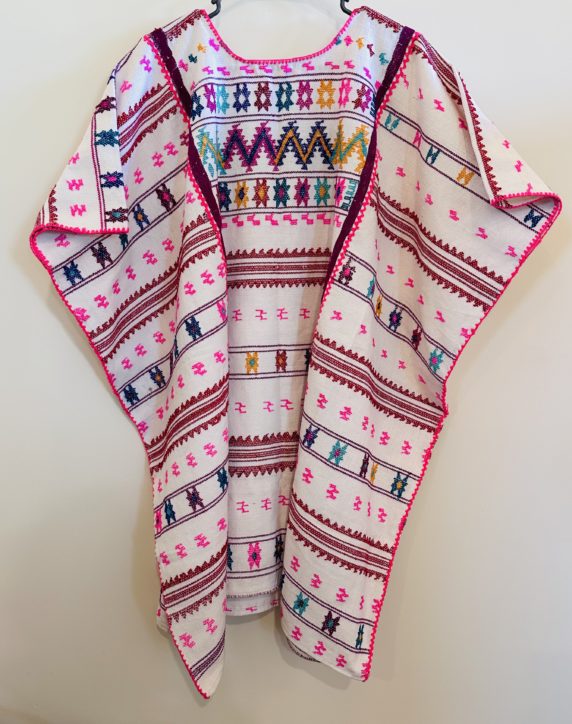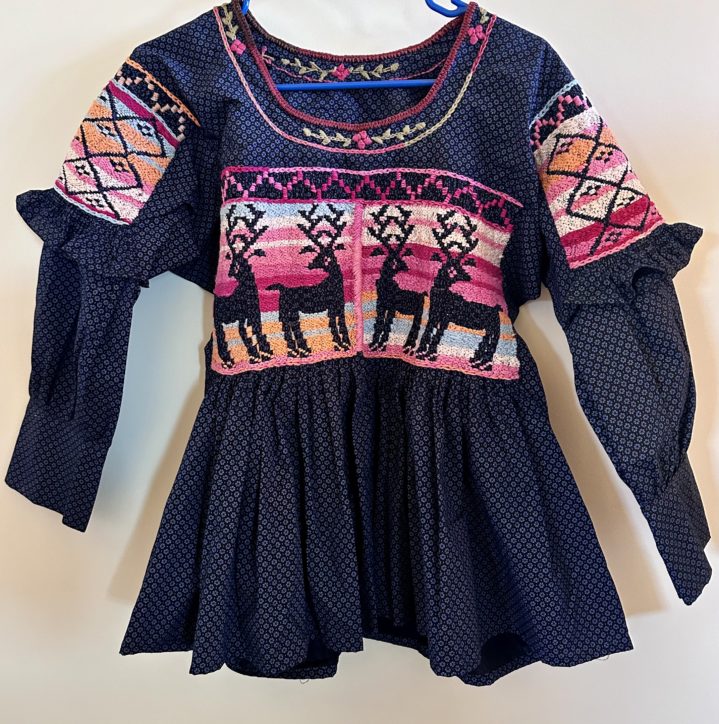The Feria del Carrizo is happening this week in the Zapotec village of San Juan Guelavia. The last day is February 7. This annual fair is growing and this year there were hundreds of people on opening day, Sunday, January 31.
I have made this an annual tradition and this was my fourth year here. I love arriving just before 10 a.m. when the weavers are setting up shop and the cooking fires are roaring. This couple, above, still makes the reed fish traps. They make great lampshades or dried flower holders!
Just in time for a breakfast of traditional hot chocolate made with water (or milk, if you prefer). It’s a great accompaniment to hot off the griddle fresh made corn tortillas stuffed with yellow mole and chicken (above right) or squash blossoms , quesillo (string cheese) and mushrooms (above left). This was prepared by the volunteers from the Museo Comunitario, the community museum. Super Yummy!
The Community Museum is small, just two rooms and admission is by donation. Usos y Costumbres villages maintain museums to keep cultural history. San Juan was closely tied to neighboring Dainzu (now an archeological site) and Macuilxochitl (across the highway) was once the regional center.
Ancient map reproductions show this as well as a diorama of how salt was extracted from the earth by local women using clay vessels from nearby San Marcos Tlapazola. Villagers were active in the Mexican Revolution that hit the region hard because was dotted with haciendas that indentured indigenous labor, eradicated with the Revolution.
Of course, the food goes on all day and if you wait long enough and stay for lunch you can enjoy barbecue goat tacos along with a shot of Tobala mezcal (or Madrecuixe, as your taste dictates) straight from the palenque. Buy a bottle for 200 pesos, about 2/3 less than comparable quality in Oaxaca city!
The weavers in San Juan Guelavia work in river reed called carrizo. Their baskets were used by farmers, traders and cooks for centuries, long before the Spanish conquest in 1521.
Anthropologists have written and talked about the risks to this artisan craft of the Oaxaca valley. So much of the reed weaving is now replaced by plastic baskets because people everywhere love the bright colors.
But, preferred among the local ladies is the traditional market shopping basket –that round Carrizo basket with curved palm covered handle that fits comfortably in the crook of the elbow.
I use the low-sided baskets as “shipping containers” inside my luggage. I’ve put mezcal bottles and ceramics inside, wrapped in bubble, surrounded by soft clothes packed snugly and nothing ever arrives broken. Use a flat round tray to cover your stuff and secure with duct tape. Very easy!
Above left, the ladies prepare atole, a traditional corn drink. Mix it with chocolate for a special taste. Always served at festivals, it’s the drink of the Zapotec and Aztec gods. Above right, a grandmother ties the sash on her granddaughter’s skirt in preparation for the parade.
Above: This year, there were lots of necklaces strung with reed and bright beads. Some dangled with mini- baskets mini-atole cups (all handmade).
And, above right, toy trucks and airplanes and whistles for the children, bird cages and shelves for home decor.
How to Get There From Oaxaca City: Take a taxi or collectivo or bus that goes to Tlacolula. Get off at the San Juan Guelavia crucero (crossroads). From there, take a moto-taxi (we call them tuk-tuks into town.) The village is situated about a mile inland on the west side of the Carretera Nacional MX190 better known as the Pan-American Highway.




























Feria del Carrizo, San Juan Guelavia — Sunday, February 4, 2018 — Don’t Miss It!
Carrizo is hand-woven river reed. It’s another form of artisan weaving here in the Valles Centrales de Oaxaca — the Central Valleys of Oaxaca. The village most well-known for their baskets made from this plant material that is similar to bamboo is San Juan Guelavia. It’s just across MEX 190 Carretera Nacional from where I live in Teotitlan del Valle, about 40 minutes outside Oaxaca City on the road to Tlacolula.
Jessica and the ladies shopping for handmade river reed baskets
The Basket Festival runs two Sundays each year, the last Sunday in January and the first Sunday in February. It has grown to become an extravaganza, complete with a mini-Guelaguetza style dance festival, amazing homemade food including barbecue lamb, hot-off-the griddle tortillas, quesadillas, memelitas, fresh fruit waters, beer and mezcal.
This was a mini-Guelaguetza with lots of dancing
In fact, these local festivals bring out artisanal mezcal distillers who do not export but have managed to bottle and label their elixir. After sharing an agua miel, the first juice of the pulque cactus before it begins to ferment into pulque, and after lunch on our way out, Jessica and I decided to stop for a mezcal tasting along the roadside.
This giant balloon is not easy to twirl while walking
The 200 peso bottle of local Madrecuishe was every bit as good as those I have bought and tasted from brands that are marked with a fancy art label and exported to the USA where you can buy it for $200 USD. Two hundred pesos, my friends, is $11 USD.
A prayer at the altar with mezcal toast signals that the festival can begin
Some say Oaxaca is changing because of the mezcal craze. Foodies and beverage hounds are arriving by the plane full to frequent mezcal bars and upscale restaurants.
Young children learn the dance traditions early
But, life in our pueblos continue as it has over time with just a few modifications.
The Feria del Carrizo something I always look forward to and I’m very happy when I am here at the end of January to savor the experience. I’ve attended this fair since 2013, its second year.
Barbacoa de borrego (lamb BBQ)–served with fresh squeezed lime & shredded cabbage
Early on, the fair featured the basket makers who sold their craft from the raised platform surrounding the zocalo. Perhaps a few hundred people attended.
Do you see the guajalote feet? Part of the offering to the mayordomos.
Now, the basket vendors line the main street along with carnival rides, pulque and mezcal sellers, and red clay potters from neighboring San Marcos Tlapazola. The raised platform is filled with people eating on portable tables and folding chairs. The zocalo is a constant flow of performers, the periphery is lined with food stalls. Thousands were enjoying a sunny Oaxaca day.
Opening ceremonies featured a group honoring the mayordomos
If you want a taste of village life, spend Sunday, February 4 in San Juan Guelavia. Sip agua miel for 15 pesos. Get a bowl full of barbacoa for 70 pesos. Drink a beer for 20 pesos. Buy a beautiful basket for 150 pesos. Enjoy the dancing and music, and people-watching. It’s free.
Like this:
4 Comments
Posted in Cultural Commentary, Travel & Tourism
Tagged carrizo, festival, Mexico, Oaxaca, river reed, San Juan Guelavia, woven baskets